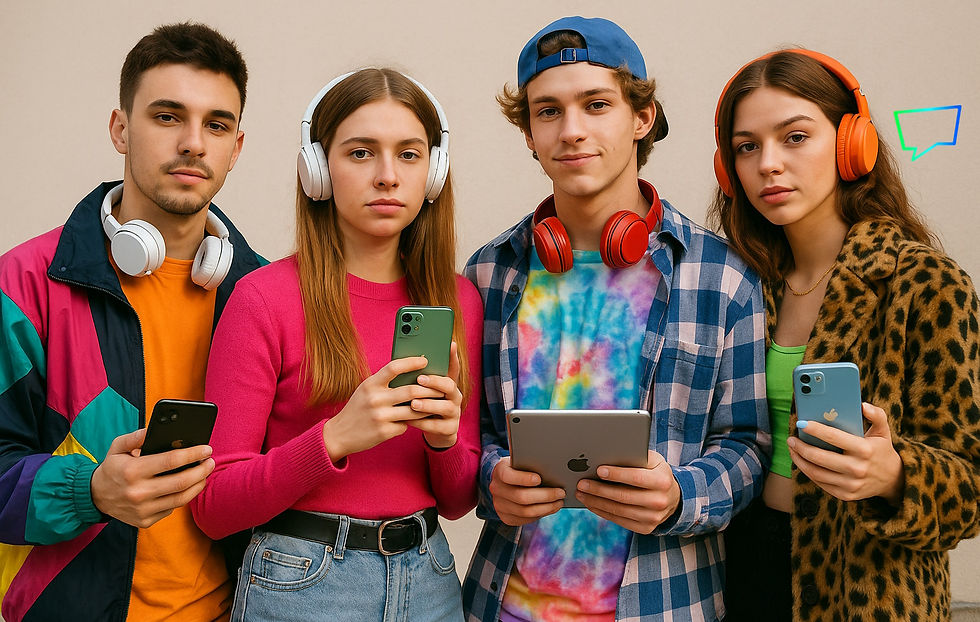Gen Z Decoded: From Memes to Meetings
- Krešimir Sočković

- Sep 30
- 4 min read
Gen Z – those kids who grew up with a phone in their hands, who don’t remember life without the internet, and who shared their first meme before they even learned multiplication tables.

If you want to understand them – whether you’re leading a team, teaching a class, or trying to sell them something – forget the old-school playbook. No, tossing an emoji 😎 into an email and calling yourself “digitally savvy” won’t cut it. You’ll need a bit more fine-tuning. So, let’s break it down.
Communication Styles
Picture this: you send a Gen Z colleague a three-paragraph email. You wait. Days pass. Nothing. Then at 10:43 PM you get a chat ping: “Hey! Is this urgent? 😊” Welcome to their world.
Unlike boomers who still love to “resolve things on the phone,” Gen Z writes. Short. Fast. Straight to the point. With the occasional GIF. Instead of “Dear colleague, please review the report,” they’ll type: “Hey, is this ok? 👇” and drop a link.
Their comfort zones are Slack, WhatsApp, and Teams chat – not because they’re lazy, but because that’s their language. And while they may sit silently in meetings, they’re often messaging in the background: “This guy talks like he’s reading PowerPoint slides.” Just because you don’t hear them doesn’t mean they’re not talking.
What works:
Quick chats instead of endless meetings.
Clear instructions, with the “why” explained.
Visuals – a diagram beats a Word doc.
Instant feedback: a like, comment, emoji, anything.
Real talk when needed: “This isn’t great. Let’s fix it together.”
How older colleagues can connect:
Don’t play the 90s movie boss. Be human.
If you mess up, say: “My bad.”
Admit when you don’t know something – they might surprise you.
Keep 1:1s short (15 min) and let them know it’s safe to ask anything.
Case in point: Instead of a long slide deck, a Gen Z colleague makes a quick CapCut video with music and memes – and the whole team actually watches it. Because it’s human, short, and fun.
Education – When YouTube Becomes the Textbook
Learning styles:
Remember those 300-page textbooks? Gen Z will watch three YouTube videos, two TikToks, and one Reddit thread – and know more than you. Seriously.
They don’t want 45 minutes of one-way lecturing, imagining their teacher droning on with elevator music in the background. What they want is:
Discussions: “What do you think?”
Live quizzes (Kahoot = adrenaline).
Short videos, infographics, real-life examples.
Their attention span? About 8 seconds. If you don’t grab them immediately, they’re mentally building their commute playlist.
What works in class:
Active learning: group projects, debates, problem-solving.
Micro-learning: bite-sized lessons.
Visualization: memes, clips, diagrams.
Instant feedback: “Great question! Here’s how it connects.”
How teachers can connect:
Show energy (yes, even when you’re tired).
Be honest: “This topic’s tricky for me too, let’s figure it out.”
Don’t fear tech – ask for help.
Admit gaps – it makes you more credible.
🔹 Example: Instead of homework, a teacher asks students to film a TikTok explaining photosynthesis. They learn (and remember) more than from a textbook.
Marketing – When Ads Need to Be Memes
Content styles:
Picture Gen Z scrolling. And scrolling. Until something makes them stop. Usually it’s a 9-second clip that’s funny, real, and not screaming “Buy now!”
They don’t want to be sold to – they want to be entertained, included, and see that your brand gets it. Authenticity is everything. Fake it, and they’ll swipe you away faster than a CD player in 2025.
What works:
TikTok, Reels, Shorts – fast, vertical, relatable.
Influencers who are raw, imperfect, real.
User-generated content.
Polls, challenges, reactions – two-way communication.
Real values – but only if you truly mean it.
What to avoid:
Over-polished ads with actors in suits.
Forced slang (“Yo fam, is this 🔥?” – no).
Ignoring comments.
How brands can connect:
Join the conversation – reply when tagged.
Own up to mistakes. Apologize. Authenticity = respect.
Forget “slogan of the year” – say: “Here’s what we’re doing and why.”
Ask for their opinion. And act on it.
Market example: A brand posts a TikTok of employees dancing while showing how they pack products – and it goes viral. Not because it’s perfect, but because it’s real.
The Bottom Line – Communication = a Two-Way Street
Gen Z doesn’t “lack communication skills.” They communicate all the time – just differently. And they can spot fakeness a mile away.
If you want them to hear you:
Speak clearly.
Listen more.
Include them.
Admit mistakes.
Give them room to grow.
You don’t need to film TikToks yourself. But you can say: “Hey, show me how.” That’s already step one.
Final Thought
Gen Z isn’t asking for handholding. They want meaning, respect, and authentic communication. Treat them as equals, and you’ll get ideas, engagement, and loyalty. Force them into outdated molds, and they’ll look at you like you just handed out fax paper instead of a presentation.



Comments